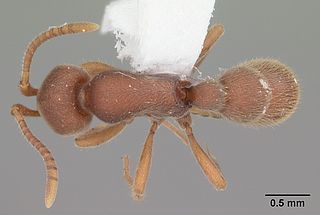
Theridiidae, also known as the tangle-web spiders, cobweb spiders and comb-footed spiders, is a large family of araneomorph spiders first described by Carl Jakob Sundevall in 1833. This diverse, globally distributed family includes over 3,000 species in 124 genera, and is the most common arthropod found in human dwellings throughout the world.

The triangulate cobweb spider is a common spider in the genus Steatoda. It is well known for the triangle-shaped pattern on the dorsal side of its abdomen.

Anatea formicaria is an ant-mimicking spider. It is only known from the rain forest of New Caledonia. Before 1967, it was considered to belong to the family Clubionidae. It was placed there based on the ant-like outward modifications and male genitalia, which superficially resemble those of the genus Micaria. In fact it is closely related to the genera Euryopis and possibly Achaearanea.

Myrmecophagy is a feeding behavior defined by the consumption of termites or ants, particularly as pertaining to those animal species whose diets are largely or exclusively composed of said insect types. Literally, myrmecophagy means "ant-eating" rather than "termite eating". The two habits often overlap, as both of these eusocial insect types often live in large, densely populated nests requiring similar adaptations in the animal species that exploit them.

Dasymutilla is a wasp genus belonging to the family Mutillidae. Their larvae are external parasites to various types of ground-nesting Hymenoptera. Most of the velvet ants in North America—the wingless females of which are conspicuous as colorful, fast, and "fuzzy" bugs—are in the genus Dasymutilla.

Spiders are air-breathing arthropods that have eight limbs, chelicerae with fangs generally able to inject venom, and spinnerets that extrude silk. They are the largest order of arachnids and rank seventh in total species diversity among all orders of organisms. Spiders are found worldwide on every continent except Antarctica, and have become established in nearly every land habitat. As of September 2024, 52,309 spider species in 134 families have been recorded by taxonomists. However, there has been debate among scientists about how families should be classified, with over 20 different classifications proposed since 1900.

Euryopis flavomaculata is a tangle-web spider species with Palearctic distribution. It is notably found in Lithuania.

Nesticodes is a monotypic genus of comb-footed spiders containing only the red house spider [Nesticodes rufipes ]. It was first described by Allan Frost Archer in 1950, and has a pantropical distribution due to ship and air travel.

Myrmecophilus pergandei, the eastern ant cricket, is a species of ant cricket in the family Myrmecophilidae. It is found in North America. It is a wingless cricket that is an obligate kleptoparasite of ants living in their nests. They lack both wings and tympanal organs on the front tibia.
Steatoda variata is a species of cobweb spider in the family Theridiidae. It is found in the United States and Mexico.
Crustulina altera is a species of cobweb spider in the family Theridiidae. It is found in the United States.
Steatoda grandis is a species of cobweb spider in the family Theridiidae. It is found in the United States.
Euryopis tavara is a species of cobweb spider in the family Theridiidae. It is found in the United States.

Proceratium pergandei is a species of ant in the family Formicidae. It is endemic to the Central and Eastern United States.

Euryopis funebris is a species of cobweb spider in the family Theridiidae. It is found in the United States and Canada.

Formica pergandei is a species of ant in the family Formicidae.

Euryopis argentea is a species of cobweb spider in the family Theridiidae. It is found in the United States, Canada, and Russia.

Euryopis splendens is a species of comb-footed spider in the family Theridiidae. The range of distribution is the south east of Australia. The spider lives under stones or bark.
Dipoena santacatarinae is a species of araneomorphae spider in the family Theridiidae.
Latrodectus revivensis, also known as the desert widow, is a species of venomous spider belonging to the Latrodectus genus and located in the Negev desert and the Arava valley (Arabah).












